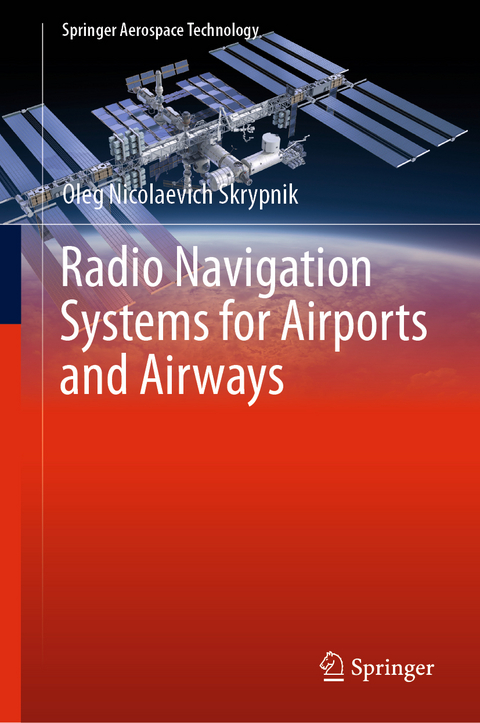
Radio Navigation Systems for Airports and Airways
Springer Verlag, Singapore
978-981-13-7200-1 (ISBN)
Dr. Skrypnik is Professor and Chair of the Department of Aviation Radio Equipment at the Moscow State Technical University of Civil Aviation. He is an Honored Worker of high professional education of Russian Federation (2004), and a Full Member of the Russian Academy of natural sciences. He is an author of more than 100 scientific publications, 12 professional textbooks and aids on aviation radio equipment.
CHAPTER 1. ELEMENTS OF THE GENERAL RADIO NAVIGATION THEORY
1.1. Air navigation and its technical aids overview
1.2. Main building principles and classification of radio-navigation aids
1.3. Main navigation notions and terms
1.4. Coordinate systems used in air navigation
1.5. Lines and surfaces of position
1.6. Methods of aircraft's position determination
1.7. Coverage areas of essential radio navigation systems types
1.7.1. Methodology of coverage area construction
1.7.2. Coverage area of theta-theta navigation system
1.7.3. Coverage area of rho-rho radio navigation system
1.7.4. Coverage area of rho-theta navigation system
1.7.5. Coverage area of hyperbolic fixing (range difference) navigation system
1.8. Aeronautical consumers' requirements to the navigation accuracy
CHAPTER 2. DIRECTION MEASURING SHORT-RANGE NAVIGATION SYSTEMS
2.1. General Characteristics of Short-Range Navigation Systems
2.2. Non-Directional Beacons (NDB)
2.2.1. Application and Missions
2.2.2. NDB Placement
2.2.3 A Generalized Block-Diagram and Operation Principle of an NDB
2.2.4. NDB Design and Basic Specifications
2.3. Aviation VHF Direction Finders
2.3.1. Function, general characteristics, on-aerodrome location
2.3.2. Principles of forming and processing information in DFs
2.3.3. Design and main specifications of DFs
CHAPTER 3. RHO-THETA SHORT-RANGE RADIOTECHNCAL NAVIGATION
SYSTEMS
3.1. Common characteristics of rho-theta short-range radiotechnical navigation system
3.2. VOR system
3.2.1. Main characteristics and the purpose of system
3.2.2. Unified structural configuration and VOR system's operating principle
3.2.3. DVOR system operating principle
3.2.4. Constrction and main technical characteristics of VOR (DVOR) radio beacons
3.3. DME distance-measuring system
3.3.1. Function and general characteristics of the system
3.3.2. DME generic block diagram and operation principle
3.3.3. Design and main specifications of DME beacons
CHAPTER 4. RADIOTECHNICAL LANDING SYSTEMS
4.1. Classification and categories of landing systems
4.2. General description of radiotechnical landing systems
4.2.1. NDB-based landing systems
4.2.2. Radar landing systems
4.2.3. Radio beacon landing systems
4.3. Instrument Landing System
4.3.1. Principles of construction and operation
4.3.2. Equisignal radio beacons
4.3.3. "Zero-referenced" (CSB/SBO) radio beacons
4.3.4. Twin-channel radio beacons
4.3.5. Processing of ILS signals by airborne equipment
4.4. Marker beacons
4.5. Design and main specifications of ILS radio beacons
CHAPTER 5. LANDING SYSTEMS BASED ON SATELLITE NAVIGATION SYSTEMS
5.1. General Information of SNS
5.1.1. Performance features and structure of Satellite Navigation Systems
5.1.2. Parameters of orbit groups and the contents of ephemeris information
5.1.3. Signal structure
5.1.4. Principles of solving a navigational problem
5.2. Factors influencing SNS accuracy
5.3. Methods of increasing the accuracy of navigational sightings by SNS data
5.3.1. Operation in a combined mode
5.3.2. Operation in a differential mode
5.3.3. Functional additions recommended by ICAO
5.3.4. Application of Pseudo Satellites
5.4. Design and general performances of LAAS of LKKS-А-2000 -type
CHAPTER 6. MULTIPOSITION (MULTILATERAL) SURVEILLANCE SYSTEMS
6.1. General description of multiposition (multilateral) surveillance systems (MLAT)
6.2. Aircraft coordination detection principle in MLAT
6.3. Typical versions of MLAT architecture
6.4. Crucial factors for MLAT accuracy
6.5. Requirements for MLAT performance
| Erscheinungsdatum | 15.04.2019 |
|---|---|
| Reihe/Serie | Springer Aerospace Technology |
| Zusatzinfo | 154 Illustrations, color; 10 Illustrations, black and white; XVII, 226 p. 164 illus., 154 illus. in color. |
| Verlagsort | Singapore |
| Sprache | englisch |
| Maße | 155 x 235 mm |
| Themenwelt | Informatik ► Theorie / Studium ► Algorithmen |
| Technik ► Fahrzeugbau / Schiffbau | |
| Technik ► Luft- / Raumfahrttechnik | |
| Technik ► Nachrichtentechnik | |
| Schlagworte | Aircraft navigation and landing • Air Navigation • Air Traffic Management • Multiposition surveillance systems (MLAT) • Non-Directional Beacons (NDB) • Radar landing systems • Radio technical landing systems • Satellite navigation systems • Short-Range Navigation Systems • Twin-channel radio beacons |
| ISBN-10 | 981-13-7200-4 / 9811372004 |
| ISBN-13 | 978-981-13-7200-1 / 9789811372001 |
| Zustand | Neuware |
| Haben Sie eine Frage zum Produkt? |
aus dem Bereich


